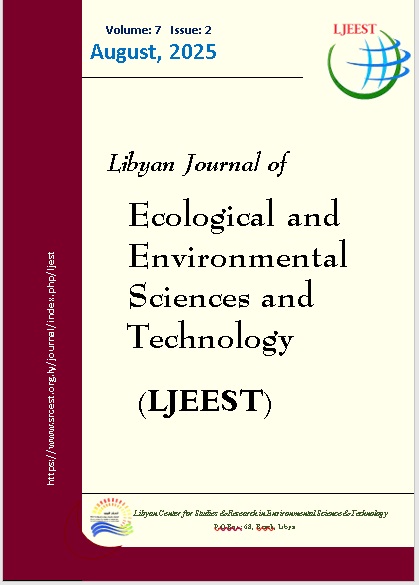Slope Instability, Landsliding and Hazards Analysis at Highway Roadcut
DOI:
https://doi.org/10.63359/f5cava93Keywords:
hazards, road cut, landslides, rock failure, Slope instabilityAbstract
The stability of rock slopes is crucial to public safety in highways passing through rock cuts. Slope instability and failures occur due to many factors such as adverse slop geometries, geological discontinuities, weak or weathered slope materials as well as severe weather conditions. External loads like heavy precipitation and earthquakes could play a significant role in slope failure. The main objective of this study is to assessment the stability of rock slopes throughout the passing highway and hazard potentiality. In this paper, several rock mass classification systems for rock slope stability assessment were critically evaluated against known rock slope conditions in the northeastern region of Libya to includes two areas are Al Bakour area and Al Shaliony area that located east Benghazi city. The investigated rock formations in both areas are mainly formed of carbonate rocks that represented by chalk, limestone, dolomite in addition to the intercalated shale, with cliffs features of slope angle ranging from 70 to 90º. Also, these formation are highly topographic features and varies in thickness and extensions as well as structurally patterns. The stability conditions were identified and the stability of the rock cuts have been evaluated using different procedures e. g. determining the most relevant factors affecting slope instability; interpreting the discontinuity data collected from the surveys for the assessment of the modes of failure and determining the potential unstable zones. This study reveals that the cut needs to be mitigated because of the a few outcrops of rock slopes that covered by the metal mish not enough to support protection against rock collapse an failure ongoing slope instability present in some areas, that including planar and wedge slides and raveling rock falls. It was found that the unstable rock areas create serious safety hazards to traffic
References
Australian GeoGuide, LR (Landslides) (2007) Coastline Hazard Management Study for the Wyong Shire Council Australian Geomechanics Vol. 42 No 1.
Burns, W.J., and Madin, I.P., (2009) Protocol for inventory mapping of landslide deposits form light detection and ranging (LIDAR) imagery. Oregon Department of Geology and Mineral Industries Special Paper 42, 30 p.
Çellek, S. (2022) Effect of the Slope Angle and Its Classification on Landslides. Natural Hazards and Earth System Sciences, 43(1), 85–95.
Chakrabarti S., Cheenikal L., Singh G. (2013) Em-bankment Design and Construction for a Major Rail Upgrade Project in Embankment Design And Con¬struction For A Major. Australian Geomechanics Journal, June, 1–8.
Ferardi F.D., Wilopo W., Fathani T.F. (2018) Rainfall Thresholds for Landslide Prediction in Loano Sub¬district, Purworejo District Central Java Province. Journal of Applied Geology, 3(1), 23–31.
Forbes K., Broadhead J. (2013) Forests and Land¬slides : The Role of Trees and Forests in the Preven¬tion of Landslides and Rehabilitation of Landslide- Affected Areas in Asia. Bangkok.
Franklin J., Robert P., Roberts D.W., Austin M. 2013. Vegetation Ecology, 2nd. Ed. In Vegetation Ecology, Jhon Wiley & Sons, Ltd, 71–106.
Freschet G., Violle C., Roumet C, Garnier E. (2018) Interactions between Soil and Vegetation : Structure of Plant Communities and Soil Functioning. In Soils as a Key Component of the Critical Zone 6: Ecology, ISTE Ltd and Jhon Wilye & Sons, Inc., 83–104.
Kimura K., Nagata T., Kan S. (2020) Landslide Di¬saster and Its Prevention Works in Shikoku Region of Japan Landslide Disaster and Its Prevention Works in Shikoku Region of Japan. IOP Confer-ence Series: Earth and Environmental Science, 589(012009), 1–12.
Kumar N, Verma AK, Sardana S, Sarkar K, Singh TN (2017) Comparative analysis of limit equilibrium and numerical methods for prediction of a landslide. Bull Eng Geol Environ77(2):595–608.
Lu P.L. (2014) Using Multiple Vegetation Layers to Reduce the Risk of Rainfall-Induced Landslides and Facilitate Post-Landslide Slope Rehabilitation. Ac¬cess International Journal of Agricultural Sciences, 2(2), 13–17.
Masannat Y.M. 2014. Landslide Hazards : Geo¬technical Aspects and Management Policies. Jordan Journal of Civil Engineering, 8(1), 1–22.
Park HJ, Lee JH, Kim KM, Um JG (2016) Assessment of rock slope stability using GIS-based probabilistic kinematic analysis. Eng Geol 203:56–69
Phillips C., Hales T., Smith H., Basher L. 2021. Shallow Landslides and Vegetation at the Catch¬ment Scale : A Perspective. Ecological Engineering, 173, 106436.
Polemio M., Petrucci O. 2000. Rainfall as a Land¬slide Triggering Factor : An Overview of Recent International Research. The 8th International Sym¬posium on Landslides in Cardiff, UK 3(January).
Pradhan SP, Vishal V, Singh TN (2018) Finite element modelling of landslide prone slopes around Rudraprayag and Agastyamuni in Uttarakhand Himalayan terrain. Nat Hazards 94(1):181–200
Russell, C.P., Santi, P., Higgins, J.D., 2008. Modification and statistical analysis of the Colorado rockfall hazard rating system. Colorado Department of Transportation Report CDOT-2008-7, 124 p.
Sarkar S, Kanungo DP, Kumar S (2012) Rock mass classification and slope stability assessment of road cut slopes in Garhwal Himalaya, India. Geotech Geol Eng 30(4):827–840.
Sardana S, Verma, AK, Singh A, Laldinpuia (2019) Comparative analysis of rockmass characterization techniques for the stability prediction of road cut slopes along NH-44A, Mizoram, India. Bull Eng Geol Environ.https ://doi.org/10.1007/s1006 4-019-01493 -3
Singh AK, Kundu J, Sarkar K (2018) Stability analysis of a recurring soil slope failure along NH-5, Himachal Himalaya, India. Nat Hazards 90(2):863–885.
Schulz, W.H., (2004) Landslides mapped using LIDAR imagery, Seattle, Washington. U.S. Geological Survey Open File Report 2004-1396, 11 p.
Schulz, W.H., (2007) Landslide susceptibility revealed by LIDAR imagery and historical records, Seattle, Washington. Engineering Geology, 89:76-87.
Vanderwater, C.J., Dunne, W.M,, Mauldon, M., Drumm, E.C., and Bateman, V., (2005) Classifying and Assessing the Geologic Contribution to Rockfall Hazard. Environmental and Engineering Geoscience, 11:141–154.
Verma AK, Singh TN (2010) Modeling of a jointed rock mass under triaxial conditions. Arab J Geosci3(1):91–103
Verma AK, Singh TN, Chauhan NK, Sarkar K (2016) A hybrid FEM–ANN approach for slope instability prediction. J Inst Eng (India) Ser A 97(3):171–180.
Verma AK, Sardana S, Singh TN, Kumar N (2018) Rockfall analysis and optimized design of rockfall barrier along a strategic road near Solang Valley, Himachal Pradesh, India. Indian Geotech J 48(4):686–699.
Verma AK, Sardana S, Sharma P, Dinpuia L, Singh TN (2019) Investigation of rockfall-prone road cut slope near Lengpui Airport, Mizoram, India. J Rock Mech Geotech Eng 11(1):146–158.
Vishal V, Siddique T, Purohit R, Phophliya MK, Pradhan SP (2017) Hazard assessment in rockfallprone Himalayan slopes along National Highway-58, India: rating and simulation. Nat Hazards85(1):487–503.
Widjaja H. (2018) Vegetative Engineering as Landslide Reduction and Handling Alternative. In IOP Conf. Se¬ries: Earth and Environmental Science, 203, 1–4.
Zhang Z., Chen Z. (2019) Constraint Embankment Construction to Prevent the Collapse Of. Advances in Civil Engineering, 2019, 1–18.
Downloads
Published
Issue
Section
License
Copyright (c) 2025 Libyan Journal of Ecological & Environmental Sciences and Technology

This work is licensed under a Creative Commons Attribution-NonCommercial 4.0 International License.















